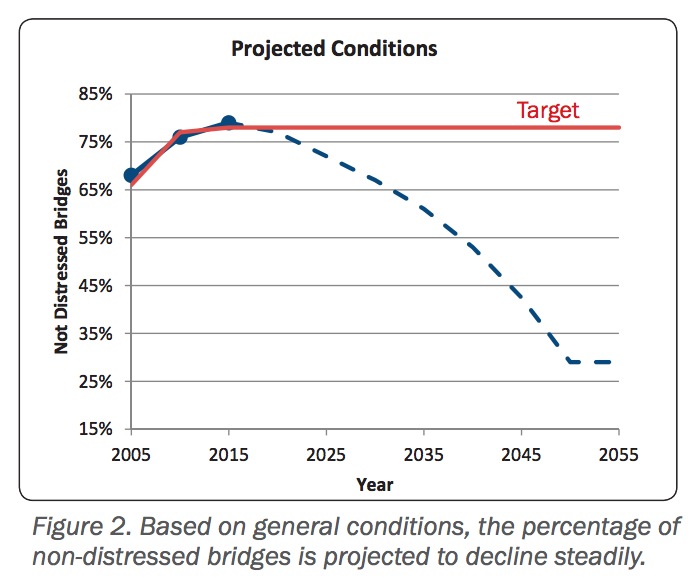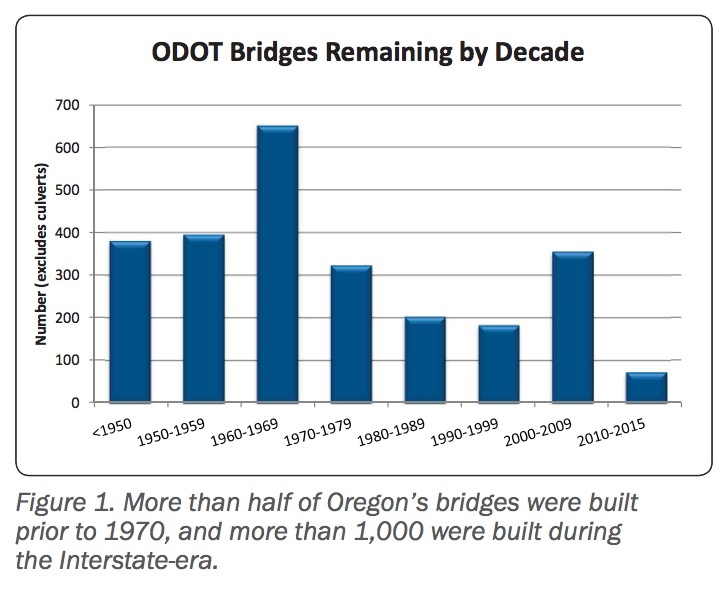OREGON DEPARTMENT OF TRANSPORTATION
Maintaining good bridges is critical to a strong economy and to preserving safe and reliable travel. Deteriorated bridges can impede mobility and force trucks to detour, costing businesses time and money. Measuring the current health of Oregon’s bridge population enables the Oregon Department of Transportation to track conditions over time to determine bridge rehabilitation and replacement needs.
ODOT’s 2015 Bridge Condition Report summarizes bridge condition ratings on state highways and performance measures based on National Bridge Inventory and ODOT data. As a consistent reference point for evaluation, ODOT uses the bridge conditions snapshot provided annually to the Federal Highway Administration. Data from the April 2015 submittal is the basis of this report.
ODOT measures bridge conditions using two categories of characteristics:
- Structurally deficient as defined by the Federal Highway Administration — meaning the bridge has deteriorated deck, substructure or superstructure that requires repair.
- Other deficiencies as defined by ODOT, including freight mobility, bridge safety and serviceability needs.
A distressed bridge is one that is rated as structurally deficient or has at least one other deficiency. ODOT targets both aspects in determining bridge needs and selecting projects for the Statewide Transportation Improvement Program.
Current Conditions
Oregon’s state highway bridge conditions have improved since 2007. A significant increase in bridge program funding from the 2003 Oregon Transportation Investment Act (OTIA III) and special federal funding in 2008 and 2009 resulted in the largest spike of new bridge construction since the 1960s.
The $1.3 billion OTIA III State Bridge Delivery Program, completed in 2014, addressed aging bridges on Oregon’s highway network. The program repaired 122 bridges and replaced 149 — about 10 percent of the 2,727 bridges on the state highway system — improving bridge conditions while increasing safety and facilitating the free movement of goods.
These new bridges and a large number of rehabilitation projects have improved Oregon’s current bridge conditions. In 2015, 79 percent of state highway bridges, 86 percent of bridges on interstate highways and 79 percent of bridges on the National Highway System are not distressed. The improvement trend, however, is not expected to continue in the long term.
 An Aging System and Declining Revenue
An Aging System and Declining Revenue
While the OTIA III bridge program allowed for a significant, if temporary, “catchup” in bridge conditions on important freight routes, projections show significant deterioration in conditions in the next several decades due primarily to aging structures and reduced funding.
More than half of the bridges in the state’s current inventory were built prior to 1970 (Figure 1), and 57 percent will reach the end of their design lives by 2020. Of those, 18 percent are currently one point away from structural deficiency. Each year, about 0.5 percent of the state’s bridges — about 14 structures — deteriorate to the point of becoming structurally deficient. By 2020, that rate is expected to increase to 2.5 percent or close to 70 structurally deficient bridges each year.
Download full version (PDF): 2015 Bridge Condition Report
About the Oregon Department of Transportation
www.oregon.gov/ODOT
The Oregon Department of Transportation began life in 1913 when the Oregon Legislature created the Oregon Highway Commission to “get Oregon out of the mud.” Today, the Oregon Department of Transportation works to provide a safe, efficient transportation system that supports economic opportunity and livable communities for Oregonians. We develop programs related to Oregon’s system of highways, roads, and bridges; railways; public transportation services; transportation safety programs; driver and vehicle licensing; and motor carrier regulation.
Tags: OR, Oregon, Oregon Department of Transportation, Oregon DOT







 RSS Feed
RSS Feed